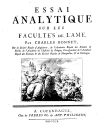Charles Bonnet Syndrome: Case series
- PMID: 29213612
- PMCID: PMC5619034
- DOI: 10.1590/S1980-57642009DN30100012
Charles Bonnet Syndrome: Case series
Abstract
Since its first description in 1760, Charles Bonnet syndrome (CBS) has been reported in many studies. The main characteristics are visual hallucinations, preserved awareness of unreal visions, and absence of psychotic symptoms. CBS can occur with lesions located anywhere along the central visual pathway, from the eye to the calcarine fissure.
Objective: To describe patients with CBS and carry out a review of the literature.
Methods: Six patients with visual hallucinations were evaluated in an outpatient memory clinic between 2001 and 2008, and their clinical characteristics recorded.
Results: Four patients were female, and the mean age was 74.5±16.9 years. Three patients had visual loss secondary to eye disease and three due to cerebral lesions. The visions consisted of animals, persons, moving objects, bizarre creatures or colored forms, and were considered disturbing by five patients. Five patients received treatment, and only three reported partial benefit from the therapy. Complete recovery was not seen in any of the subjects.
Conclusions: CBS is relatively rare and its recognition is important to avoid misdiagnoses with psychiatric or dementing illnesses.
Desde sua descrição em 1760, a Síndrome de Charles Bonnet (SCB) tem sido relatada em vários estudos. Suas características centrais são: alucinações visuais, consciência preservada sobre as alucinações e ausência de sintomas psicóticos. SCB pode ocorrer com lesões desde o olho até o córtex calcarino.
Objetivo: Descrever pacientes com SCB e fornecer revisão da literatura.
Métodos: Seis pacientes com alucinações visuais foram avaliados em um ambulatório de memória no período de 2001 a 2008 e suas características foram descritas.
Resultados: Quatro pacientes eram do sexo feminino, e a idade média foi de 74,5±16,9 anos. Três dos pacientes apresentavam perda visual secundária a lesões oculares e três devido a lesões cerebrais levando a comprometimento visual. O conteúdo das visões consistia de animais, pessoas, objetos em movimento, criaturas bizarras ou formas coloridas. Cinco pacientes receberam tratamento, e apenas três relataram benefício parcial. Melhora completa não foi observada.
Conclusões: SCB é relativamente rara e seu reconhecimento é importante para evitar erros diagnósticos com doenças psiquiátricas ou quadros demenciais.
Keywords: Charles Bonnet syndrome; visual hallucinations; visual loss.
Conflict of interest statement
Disclosure: The authors reports no conflicts of interest.
References
-
- Damas-Mora J, Skelton-Robinson M, Jenner FA. The Charles Bonnet syndrome in perspective. Psychol Med. 1982;12:251–261. - PubMed
-
- DeMorsier G. The Charles Bonnet syndrome: visual hallucinations in the aged without mental deficiency. Ann Med Psychol (Paris) 1967;2:678–702. - PubMed
-
- Bonnet C. Essai analytique sur les aculties de lame. Copenhagen: Ferres & Philibert; 1760. pp. 426–429.
-
- Ffytche DH, Howard RJ. The perceptual consequences of visual loss: positive pathologies of vision. Brain. 1999;122:1247–1260. - PubMed
-
- Norton-Willson L, Munir M. Visual perceptual disorders resembling the Charles Bonnet syndrome: a study of 434 consecutive patients referred to a psychogeriatric unit. Fam Pract. 1987;4:27–31. - PubMed
LinkOut - more resources
Full Text Sources


